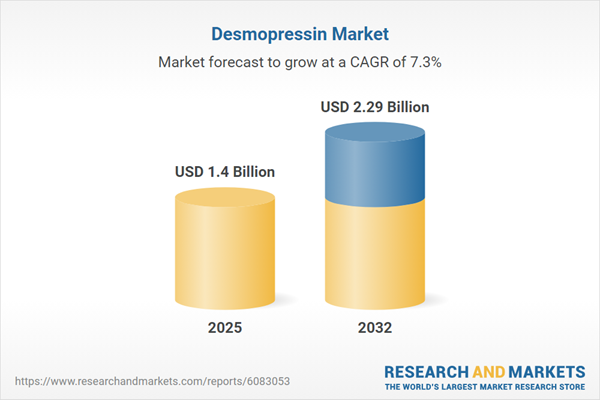Speak directly to the analyst to clarify any post sales queries you may have.
The desmopressin market is rapidly evolving, with therapeutic advancements, digital integration, and adaptive logistics creating new opportunities for healthcare organizations. Senior decision-makers require structured and actionable insights to drive strategy and innovation in this increasingly complex pharmaceutical landscape.
Market Snapshot: Desmopressin Market Size and Growth Dynamics
The Desmopressin Market achieved a global value of USD 1.30 billion in 2024 and is anticipated to reach USD 1.40 billion in 2025. With a sustained CAGR of 7.27%, projections indicate the market could exceed USD 2.29 billion by 2032. Current growth is driven by innovation in therapy options, expanding digital healthcare tools, and refined supply-chain management. Providers and suppliers are responding to shifting clinical needs across acute and chronic care, increasing the relevance of desmopressin therapies in global healthcare environments. The desmopressin market thus remains sensitive to changing demands, promising steady opportunities for adaptive industry players.
Scope & Segmentation: Unpacking Market Complexity
This comprehensive report dissects the global desmopressin market by segmenting key drivers, delivery formats, and access channels to equip stakeholders with actionable clarity on growth trends.
- End Users: Clinics, public and private hospitals, and home care settings, reflecting expansion into ambulatory and at-home care models.
- Indications: Bleeding disorders, such as Hemophilia A and Von Willebrand Disease, central diabetes insipidus, and nocturia, recognizing the therapy's application across both common and rare health conditions.
- Product Types: Injection (intravenous, subcutaneous), intranasal spray, and oral tablet, illustrating diversified approaches to match clinical requirements and user preferences.
- Route of Administration: Intranasal, intravenous, oral, and subcutaneous, signaling the adoption of patient-centric innovations for improved therapeutic adherence.
- Distribution Channels: Offline retail—including health and wellness stores, specialty and supermarket outlets—and digital sales platforms, supporting omnichannel strategies to extend accessibility and engagement.
- Geographic Coverage: Americas (notably the United States, Canada, Mexico, Brazil, Argentina, Chile, Colombia, Peru), Europe, Middle East & Africa (including the United Kingdom, Germany, France, South Africa, Nigeria), and Asia-Pacific (featuring China, India, Japan, Australia, South Korea, Indonesia, and more), with attention to regulatory frameworks and market-entry dynamics.
- Key Players Profiled: Ferring International Center S.A., Pfizer Inc., Viatris Inc., Novartis AG, Teva Pharmaceutical Industries Ltd., Sanofi S.A., Takeda Pharmaceutical Company Limited, Baxter International Inc., Sun Pharmaceutical Industries Ltd., and Dr. Reddy's Laboratories Ltd.
Key Takeaways for Senior Decision-Makers
- The desmopressin market is increasingly important for modern healthcare pathways, supporting effective endocrine therapy and management of complex bleeding episodes.
- Extended-release formulations and the development of micro-needle delivery options are advancing patient compliance and providing less invasive solutions than traditional methods.
- Adoption of digital monitoring and remote titration expands the reach of personalized care and telehealth, aiding specialist access and optimizing resource allocation.
- Omnichannel distribution and targeted educational initiatives foster greater patient engagement and awareness, supporting adoption in both clinical settings and communities.
- The need for robust sourcing strategies and cold-chain logistics is intensifying, as operational resilience becomes a focal point for risk mitigation and continued market stability.
Impact of United States Tariff Measures
Recent U.S. tariff changes have added complexity for manufacturers relying on offshore active ingredient supply. Companies are enhancing supplier networks, expanding nearshoring activities, and deepening ties with domestic producers and logistics partners. These strategies, combined with proactive pricing controls, are reinforcing supply continuity and preserving market stability amid fluctuating regulatory environments.
Methodology & Data Sources
The analysis integrates primary interviews with clinical leaders, supply chain specialists, and executive stakeholders, reinforced by secondary review of scientific literature, regulatory materials, and proprietary databases. Ongoing industry monitoring and expert validation support the accuracy and integrity of the findings presented.
Why This Report Matters for Business Strategy
- Empowers senior leaders with granular competitive and market segmentation data to inform portfolio and regional expansion decisions within the desmopressin therapy landscape.
- Provides operational guidance for addressing supply chain disruption through technology adoption and scenario-based planning.
- Enables identification of emerging, tech-enabled care models and novel geographic opportunities, strengthening future-ready business strategies.
Conclusion
This summary delivers a clear framework for strategic decision-making in the evolving desmopressin market. Companies that proactively align innovation with resilient operations and collaborative partnerships are best positioned for sustainable market leadership and improved therapeutic access.
Table of Contents
3. Executive Summary
4. Market Overview
7. Cumulative Impact of Artificial Intelligence 2025
Companies Mentioned
The companies profiled in this Desmopressin market report include:- Ferring International Center S.A.
- Pfizer Inc.
- Viatris Inc.
- Novartis AG
- Teva Pharmaceutical Industries Ltd.
- Sanofi S.A.
- Takeda Pharmaceutical Company Limited
- Baxter International Inc.
- Sun Pharmaceutical Industries Ltd.
- Dr. Reddy's Laboratories Ltd.
Table Information
| Report Attribute | Details |
|---|---|
| No. of Pages | 189 |
| Published | November 2025 |
| Forecast Period | 2025 - 2032 |
| Estimated Market Value ( USD | $ 1.4 Billion |
| Forecasted Market Value ( USD | $ 2.29 Billion |
| Compound Annual Growth Rate | 7.2% |
| Regions Covered | Global |
| No. of Companies Mentioned | 11 |









